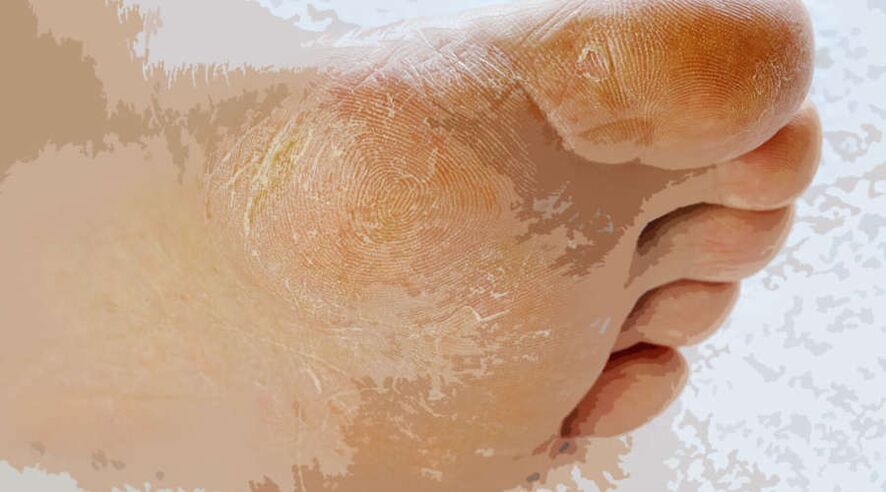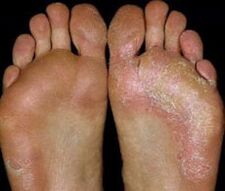
Foot mycosis (ICD code 10 B35. 3) is a fungal infection of the skin on the feet caused by parasitic dermatophytes. It occurs in about 20% of adults. Infection occurs through microtrauma, scratches, abrasions, wounds. The development of the disease is due to wet feet, diabetes mellitus, and weakened immunity.
Among people with endocrine disorders, immunodeficiency conditions, the prevalence reaches 50%. More often the disease persists in a chronic form with alternating periods of remission and exacerbation. In 40-50% of cases, foot mycosis causes onychomycosis or a fungal infection of the nails.
Where and why does the infection occur?
Foot mycosis is an infectious disease that is easily transmitted through direct contact with fungal carriers or through household items. For example, through shoes, socks, towels, manicure supplies, rubber mats in the bathroom. In 70 - 95% of cases, the causative agent of foot mycosis is Trichophyton red (Tr. Rubrum).
Typically, infections occur in public places with high humidity, where there are favorable conditions for the reproduction and spread of pathogens. These include swimming pools, public showers, saunas, water parks, gym locker rooms. If a person infected with the fungus walks barefoot on the floor or carpet in the bathroom, he or she will leave infectious particles behind. And if a healthy person steps into this place with bare feet, then the pathogen will fall on his skin. In this case, the fungus does not always appear immediately and causes the characteristic symptoms of the disease. With strong immunity, the absence of health problems, a person remains a carrier of infection, but at the same time he does not fall ill.
The risk of fungal exposure and the development of foot mycosis is increased:
- damage to skin integrity;
- violation of blood supply to the extremities, where the supply of oxygen and nutrients to the tissues worsens, the regeneration process slows down, local immunity weakens;
- diabetes mellitus, high blood glucose levels create favorable conditions for fungal growth, the development of infections;
- excessive sweating;
- dry skin, leading to microcrack;
- old age;
- blood diseases;
- long-term use of antibiotics, drugs that suppress immunity;
- vitamin deficiency;
- Wear airtight shoes and create a "greenhouse effect".
Symptoms and types of disease

Foot mycoses manifest themselves in different ways, the type of pathogen and the severity of the lesion affect the symptoms. The first signs of the disease appear in the folds between the fingers, and from there spread to the plantar, lateral, posterior sides, and nails.
How the legs look with mycosis is shown in the photo.
When the nail is infected, thickening, loss of luster, closure of the plate is observed. Nails acquire a yellow, gray, brittle, crumbling color.
Early clinical symptoms of foot mycosis include dryness, peeling of the skin, painless cracks in the folds between the toes. This form of the disease is called eradication. Peeling and cracking initially do not cause pain, itching, or discomfort. Only a doctor can see the signs of an unexplained fungal infection the first time. In addition to the obliterated, other clinical forms of foot mycosis are also distinguished, each of which has its own set of symptoms.
Squamous
In the form of squamous foot mycosis, there is exfoliation in the folds between the toes and on the sides. As a rule, there are no signs of inflammation. Redness, damage to the nails, itching, thickening of the stratum corneum, which gives the skin a glow, are possible. The papillary line becomes clearer, and the surface of the skin becomes dry, covered with lamellar scales. In this case, the patient does not feel itching or other unpleasant sensations.
Hyperkeratotic
Appears as a rash on the vault. The surface of the rash elements is covered with gray-white layered scales. There is a discharge of the epidermis, a single vesicle. When combined with each other, the rash forms a large undisturbed focus that spreads throughout the palm, including the dorsal, lateral surface. Along with the focus of exfoliation, there are areas of hyperkeratosis or thickening of the skin. They look like calluses with a slit at the top. With the hyperkeratotic form of foot mycosis, the affected area is similar to the manifestations of psoriasis or eczema. Someone worries about dryness, itching, and sometimes pain.
Intertriginous
A similar form of foot mycosis is similar to the symptoms of diaper rash. Hence the name from lat. intertrigo - "diaper rash". More often, the skin is affected in the interval between the third and fourth, fourth and fifth fingers. It becomes bright red, edematous. Weeping wounds, deep and painful cracks formed. In contrast to diaper rash, lesions on Originous intert mycosis are round with a clear outline, with white lines separating along the edges of the epidermis. The person experiences itching, burning, pain.
Dyshidrotic
The dyshidrotic form of foot mycosis is characterized by several vesicles with thick peaks, located mainly in the arch. The rash spreads to a wide area of the soles of the feet, as well as the distance between the toes and the skin of the toes. Join to form large bubbles. Where the bubble bursts, wet erosion appears. With the growth of inflammation, the skin becomes red and swollen. At the stage of vesicle formation, the patient feels unbearable itching.
Diagnostics
If you suspect foot mycosis, you should go to a dermatologist. To confirm the diagnosis, the doctor will examine the foot, asking about what symptoms are bothering the person, how long and after that they appear. Perform scraping of the affected area for microscopic analysis, culture research to identify specific pathogen types. In addition, your doctor may order a blood test.
How to treat foot mycosis?
Mycologists or dermatologists deal with the treatment of mycosis on the skin of the feet. Taking into account the clinical form of the disease, the severity of the lesion, the visible changes, the doctor will select an adequate therapy.
Complications of mycotic infections of the feet can lead to infections of hand fungus. Foot mycosis sometimes leads to secondary bacterial infections, especially when weeping sores are present on the skin.
External fungicide agents (ointments, creams), tablets for oral administration are prescribed to fight fungi. Only local therapy is effective for milder forms of foot mycosis. According to clinical guidelines, oral medications are prescribed in severe cases.
If necessary, treatment is supplemented with anti-inflammatory, drying, antiseptic, anti-allergic drugs, agents that enhance the regrowth of damaged tissue. If there are signs of a bacterial infection, antibiotic therapy is prescribed.
With onychomycosis, cleaning of the hardware from the fungal -infected area is performed. For subsequent nail processing, a local antifungal agent is prescribed: varnish, cream or ointment.
The duration of treatment is from two weeks to a month. If not only the skin is affected, but also the nails, the treatment is delayed. This is due to the fact that nails grow slowly. To get rid of the infection, a completely healthy nail plate grows back.
When a doctor's prescription is followed, mycosis can be treated successfully. But if seeing an improvement, the patient stops taking the drug, this leads to the return of the infection, its transition into a chronic form. It is necessary to complete the course completely, even if the symptoms of the disease have disappeared.
Very important in the treatment of mycosis foot care, personal hygiene, diet, selection of comfortable shoes that do not injure the affected area.
What should be done for prevention?
To prevent foot and nail mycoses or reduce the risk of their development, the following suggestions will help:
- control chronic diseases in which blood circulation in the lower extremities is affected or the body's defenses are reduced;
- Wash your feet daily with soap and water, then dry them with a towel, especially the folds between the toes;
- ventilate your shoes and change socks daily;
- Wear covered rubber slippers when visiting public showers, saunas, swimming pools, baths;
- in case of excessive sweating, use antiperspirant for feet, disinfectant for shoes, do not wear shoes, socks, tights of others;
- don't use other people's towels, wipes.
If there is a bit of peeling skin on the feet or cracks between the toes, it is a good idea to test for fungus. Early diagnosis and timely treatment will help prevent complications, severe damage, discomfort, pain while walking, and getting a bacterial infection.





























